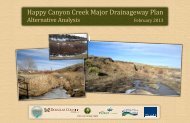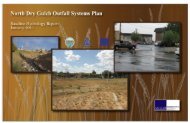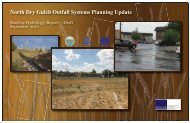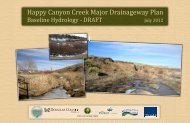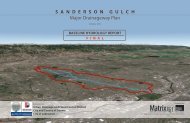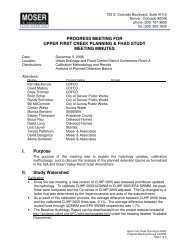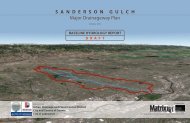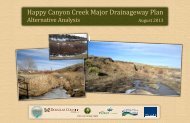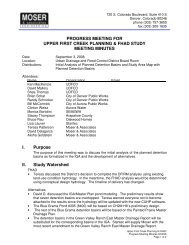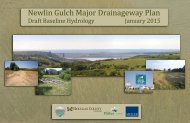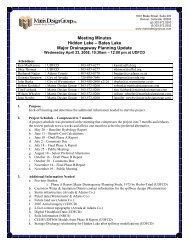Phase A - Alternatives Analysis Report - Urban Drainage and Flood ...
Phase A - Alternatives Analysis Report - Urban Drainage and Flood ...
Phase A - Alternatives Analysis Report - Urban Drainage and Flood ...
You also want an ePaper? Increase the reach of your titles
YUMPU automatically turns print PDFs into web optimized ePapers that Google loves.
PHASE A – ALTERNATIVES ANALYSIS REPORTMajor <strong>Drainage</strong>way Planning Update for Hidden Lake-Bates Lake4 HYDRAULIC ANALYSIS4.1 GeneralA Hydraulic <strong>Analysis</strong> was done on the main stem flow paths for the Hidden Lake <strong>and</strong> Bates Lakewatersheds <strong>and</strong> a tributary to the Bates Lake main stem, with the Hydraulic Engineering Center River<strong>Analysis</strong> System (HEC-RAS 3.1.3). The flows that were determined in the Baseline Hydrology <strong>Report</strong> wereused in the HEC-RAS model. <strong>Flood</strong>plain profiles <strong>and</strong> flooding extents were developed for each of thereaches in the 2-, 5-, 10-, 25-, 50-, <strong>and</strong> 100-year storm events. The results of the 100-year floodplain can beseen on Figure 4-1. A normal depth analysis was done for street hydraulics in Reach H-1 for the areaupstream of where detailed 2-foot contour data was available. This allowed approximate floodplain extentsto be established along the rest of the Hidden Lake main stem flow path.4.2 Hydraulic Evaluation of Existing FacilitiesA large portion of Reach H-1 has less than the 100-year capacity <strong>and</strong> overbank flooding is evident on thefloodplain map west of Benton Ct. The culverts in Reach H-1 at the Grace Church access road <strong>and</strong> atSheridan Blvd. do not have capacity to convey the 100-year event. Reach H-2 does not have any hydraulicdeficiencies in the 100-year storm event. In Reach H-3, the channel adjacent to Lowell Boulevard has 100-year capacity except for the elliptical culverts under 66 th Ave. Reach H-4 does not have any hydraulicdeficiencies in the 100-year storm event. The pipes <strong>and</strong> streets within Reach B-1 do not have the capacity toconvey the 100-year storm event. In addition, the pipes under the Union Pacific Railroad at the extension ofDepew St. <strong>and</strong> Sheridan Blvd. do not have 100-year capacity <strong>and</strong> this forces storm flows east into Reach B-2 along the north side of the railroad tracks. The railroad tracks in Reach B-2 are overtopped in the 100-year event.Storm pipe within the residential areas generally have between 2-year <strong>and</strong> 5-year capacity. Once thecapacity of the downstream pipe is reached, stormwater will be conveyed in the streets.The Manning’s η values used in the study vary along each of the HEC-RAS cross sections. Site visits wereconducted to determine what Manning’s η values to use for specific cover types. Typical Manning’s ηvalues used in the hydraulic analysis can be seen in Table 4-1 below.Table 4-1 Typical η ValuesDescriptionManning's η ValuesStreet Sections 0.013 - 0.015Paved Areas 0.013 - 0.018Open Grass Lined Channel 0.025 - 0035Vegitated Overbank 0.020 - 0.045There are several major structures along the Hidden Lake <strong>and</strong> Bates Lake mainstems. A list of the existingmajor structures along both the Hidden Lake <strong>and</strong> Bates Lake mainstems can be seen in Table 4-2 below.Hidden LakeMainstemBates LakeMainstemTable 4-2 Major StructuresLocationTypeSheridan Blvd.Double 4'x6' RCBCHidden LakeDam Spillway66th AveDouble 53"x34" HE-RCP65th AveDouble 83"x53" HE-RCP64th AveDouble 91"x58" HE-RCPSouth of 64th Ave96" CMPLake SangracoDam SpillwayJim BakerReservoirDam Spillway4.3 Split Flow AreasThere are three locations along the Bates Lake watershed where “split flow” was modeled in the hydrologicmodel. Split flow is defined as areas where the water can flow in more than one direction, usually adifference between pipe direction <strong>and</strong> surface topography. These locations are where the Union PacificRailroad crosses Tennyson Street, Sheridan Boulevard <strong>and</strong> the extension of Depew Street. Split flow wasmodeled at these locations because small storm sewer pipe convey minor flows under the railroad tracks toClear Creek, but the tracks act as a berm for higher flows which travel east along the north side of therailroad tracks to Jim Baker Reservoir. For the hydraulic model, the high flows that travel along the northside of the tracks were modeled as the main overl<strong>and</strong> flow path.4.4 <strong>Flood</strong>ed AreasHydraulic models have been developed to identify the structures susceptible to flooding in the 2-, 5-, 10-,25, 50-, <strong>and</strong> 100-year flood events. The extents of the 100-year floodplain can be seen on Figure 4-1. Thefloodplain delineations for this study have not been submitted to FEMA <strong>and</strong> will not be used for floodinsurance evaluations. These floodplains have been identified to determine the benefits associated withstormwater infrastructure improvements. Existing structures within these flood zones have been identified<strong>and</strong> an assessment of flood damages has been computed based upon the value of the structure <strong>and</strong> flooddepth. The structures that are inundated in the 100-year event have been shaded in tan on Figure 4-1 <strong>and</strong> arealso shown on Figures 5-1 through 5-6. A listing of the inundated buildings in each of the storm eventsstudied can be seen in Appendix F on Tables F-1 through F-6. The buildings are identified by their parcelID <strong>and</strong> their address <strong>and</strong> it is identified in the tables what type of building it is, it’s actual value, <strong>and</strong> thesource of the value estimate.4-1



